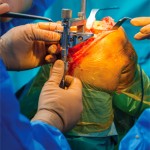Amir Atwal* is a 76-year-old man who had a knee arthroplasty six weeks ago: He wonders how he is doing in comparison to other individuals of his age at the same stage of recovery. Will you be able to provide him with an answer?
If you are looking for a one-stop shop to help you answer this and other questions related to confidently assessing impairment, function and activity in patients after knee or hip arthroplasty, check out the recently completed Total Joint Arthroplasty Outcome Measures (TJAOM) Toolkit. The TJAOM Toolkit is designed to help clinicians choose, use and interpret appropriate outcome measures for patients along the continuum of hip or knee joint arthroplasty. Developed using key concepts from the science of knowledge translation, and facilitated by the British Columbia Physical Therapy Knowledge Broker (PT KB), this project was “made possible by the passion, knowledge, skills and commitment of a multidisciplinary team of over 30 clinicians, researchers and students over a six-year period,” says PT KB Alison Hoens. TJAOM was built from the assimilation of key findings from a chart audit, focus group, survey and Delphi process, then integrated with guidelines from other arthritis initiatives focused on outcome measurements, such as those published by the Association of Rheumatology Health Professionals (ARHP) and Osteoarthritis Research Society International (OARSI).1,2
Why the Toolkit Is Important
Outcome measures are critical, not only to evaluate an individual’s current performance, but also to track progress and the effectiveness of treatment and therapies over time and across disciplines and clinical settings. Importantly, outcome measures assess the actual or perceived ability of an individual to carry out such activities as walking, dressing and completing other personal care, as well as the ability to participate in everyday activities such as work or household management.3 Standardization of outcome measures is consistently recommended to monitor progress after hip and knee arthroplasty and, if comprehensive and well chosen, can capture all domains of the International Classification of Functioning: body structure and function, activity, participation and contextual factors.4
Patients, as well as health professionals involved in their care, are interested in monitoring immediate responses to treatment, as well as longer term recovery over the entire continuum of care. Using outcome measures to evaluate the trajectory of recovery before and after surgery, we can answer clinical questions, such as: Has my patient’s function improved compared to before their surgery, and is my patient meeting important treatment milestones?
Importantly, when patients transition from one care setting to another (e.g., when they leave the acute hospital setting and continue their rehabilitation in an outpatient clinic), clinicians and patients need a common language to communicate progress. Thus, recovery can be tracked more accurately when patients, therapists and other health professionals have a standardized set of outcome measurement tools to identify and record changes in progress.
The Problem with Outcome Measures
Despite the obvious benefits of using outcome measures routinely after joint arthroplasty, in reality, practice falls considerably short of expectations.5 Our team is acutely aware of some of the challenges of fully adopting outcome measures into clinical practice.3,6
A recent systematic review highlights some of the common barriers to using outcome measures and considers why they have not yet been fully or routinely adopted into clinical practice:3 Although clinicians appreciate the value of outcome measures, practically, they find the decision-making process of selecting appropriate outcome measures confusing and intimidating.1,5 A dizzying array of outcome measures is described in the literature, yet in order to be clinically useful, each measure must have appropriate psychometric properties for that patient population and particular phase of recovery. One of the main reasons why clinicians are reluctant to use outcome measures is a lack of knowledge regarding what specific tool to use and at what stage.6
Thus, one goal of the TJAOM knowledge translation team included targeting and tailoring strategies, addressing the barriers identified by clinicians and making it easier to implement outcome measures into routine practice. To be successful, we realized that clinicians needed freely available and easily accessible resources in the clinic, removing the onus of determining which outcome measures are most suitable for each particular phase of recovery.
What’s in the Toolkit?
The TJAOM Toolkit includes:
- A summary of the recommended outcome measures (both patient-reported and performance measures) appropriate for each phase of the joint arthroplasty continuum; and
- Two formats of information to assist clinicians in selecting, administering, scoring and interpreting each measure:
- one-page written summaries and
- online interactive learning modules.
The TJAOM online learning modules were developed in cooperation with The Centre of Excellence for Simulation, Education and Innovation (CESEI) and provide the key points (with videos) on 12 patient-reported and performance-based outcome measures recommended for patients with total joint arthroplasty.7 The learning modules are freely available by creating an account at TJAOM, which will provide you with unlimited free access to the video resources within seven days of registration.
In addition, the TJAOM Toolkit also provides templates of discharge letters providing options for reporting results and communicating with referring physicians.
The entire Toolkit can be easily accessed online at http://physicaltherapy.med.ubc.ca/physical-therapy-knowledge-broker/total-joint-arthroplasty-and-outcome-measures-tjaom-toolkit.
TJAOM Toolkit Kudos
A recent evaluation of the reach of the TJAOM Toolkit revealed that it has been accessed more than 5,000 times provincially, nationally and internationally. Moreover, it is receiving recognition for its innovation and clinical utility, recently being awarded the 2016 Arthritis Health Professions Association Clinical Innovation Award.

Ms. Hoens

Ms. Lozinsky

Ms. Langford
Dolores Langford, MSc, BScPT, CHT, CAFCI, is a physiotherapy practice coordinator at Vancouver Coastal Health, B.C., Canada, and a clinical assistant professor at The University of British Columbia.
Lauren Lozinsky, BHK, MPT, CAFCI, is a registered physiotherapist at Vancouver Coastal Health, with experience in orthopedic private practice.
Alison Hoens, MSc, BScPT, PG Sports PT, is a physical therapy knowledge broker in British Columbia, a physiotherapy research, education and practice coordinator at Providence Health, B.C., Canada, and a clinical professor at the University of British Columbia.
Acknowledgments
We would like to acknowledge all members of the TJAOM Knowledge Translation Task Force for their contributions to this article: Dr. Marie Westby, chair, ARHP Practice Committee; Ronda Field; Maureen Duggan; Dolores Langford; Robyn Laytham; Steven Longstaff; Phil Sweeney; Lauren Lozinsky; and Alison Hoens.
References
- Katz PP. Introduction to special issue: Patient outcomes in rheumatology. Arthritis Care Res. 2011 Nov;63(Suppl 11)S1–S3.
- Dobson F, Hinman RS, Roos EM, et al. OARSI recommended performance-based tests to assess physical function in people diagnosed with hip or knee osteoarthritis. Osteoarthr Cartil. 2013 Aug;21(8):1042–1052.
- Jette DU, Halbert J, Iverson C, et al. Use of standardized outcome measures in physical therapist practice: Perceptions and applications. Phys Ther. 2009 Feb;89(2):125–135.
- Westby MD, Brittain A, Backman CL. Expert consensus on best practices for post-acute rehabilitation after total hip and knee arthroplasty: A Canada and United States Delphi study. Arthritis Care Res (Hoboken). 2014 Mar;66(3):411–423.
- Duncan EA, Murray J. The barriers and facilitators to routine outcome measurement by allied health professionals in practice: A systematic review. BMC Health Serv Res. 2012 May 22;12:96.
- McAuley C, Westby MD, Hoens A, et al. A survey of physiotherapists’ experience using outcome measures in total hip and knee arthroplasty. Physiother Can. 2014 Summer;66(3):274–285.
- Centre of Excellence for Simulation, Education and Innovation. 2016. https://cesei.org.
* Note: The patient name is a pseudonym.


